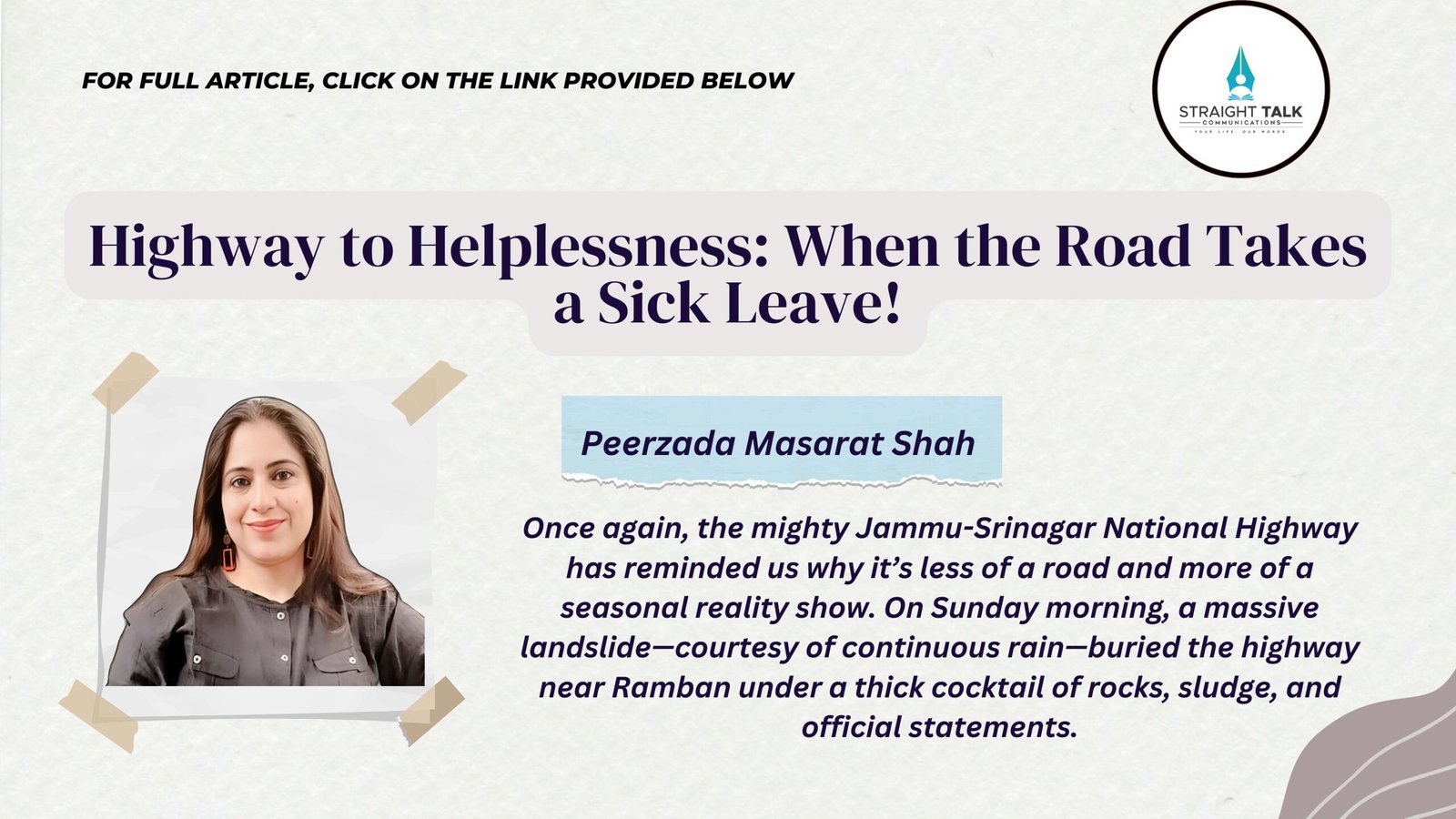Highway to Helplessness: When the Road Takes a Sick Leave!

Peerzada Masarat Shah
Once again, the mighty Jammu-Srinagar National Highway has reminded us why it’s less of a road and more of a seasonal reality show. On Sunday morning, a massive landslide—courtesy of continuous rain—buried the highway near Ramban under a thick cocktail of rocks, sludge, and official statements.
Yes, the highway has taken another extended sick leave, and this time, it’s really outdone itself. Dozens of vehicles, including private cars and heavily loaded trucks, now lie trapped in what can best be described as Mother Nature’s personal junkyard. Some were even swept into a gorge like unwanted furniture during a spring cleaning spree. Officials, with their usual poker face and well-practiced lines, reassured the public, “No loss of life reported.” Translation: it’s a miracle anyone’s still around to listen.
Live from the Mud Festival, Ramban Edition
Eyewitnesses painted a vivid picture of the chaos. “It was like a Netflix disaster movie—except there were no credits, no pause button, and definitely no popcorn,” said a stranded driver, standing beside his car that’s now more mud than machine. Roofs were torn off, roads were erased, and people were left stranded with nothing but signal-less phones and existential dread.
And just like clockwork, the response began: heavy machinery rolled in, officials started issuing advisories from their distant offices, and somewhere, a PR team scrambled to draft the phrase “restoration is underway.”
The Highway with Trust Issues
Let’s not kid ourselves. This isn’t a one-time oopsie. The Jammu-Srinagar National Highway has the structural integrity of wet tissue paper and the mood swings of a toddler denied candy. Nicknamed “India’s Killer Highway,” it’s a place where danger isn’t a possibility—it’s the default setting. In 2019 alone, it claimed 447 lives, outpacing even the numbers from the conflict zone it’s meant to connect.
Dave Petley, a respected landslide researcher and Vice-Chancellor of the University of Hull, once observed that the highway appears regularly in the global landslide fatality database. His satellite images near Ramban show a terrain so unstable, you’d expect it to come with a disclaimer: “Enter at your own risk.”
Blame It on the Fault (Literally)
Geologists think Ramban might be sitting on a fault line—because why not add tectonic instability to an already cursed geography? Combine that with deforestation, unscientific road expansion, and engineering that seems based more on trial and error than actual science, and you’ve got a recipe for routine catastrophe.
In other words, this highway is basically a landslide waiting to happen. And when it does, the only surprise is the date.
“Please Stay Indoors”—Sound Advice from People Who Don’t Have to Travel
As footage of the devastation floods social media, authorities are urging people to “avoid unnecessary travel.” Sure, tell that to the families trying to reach weddings, the patients headed for hospitals, and the traders whose livelihoods are literally stuck in the mud.
One woman, trying to make it to a family ceremony in Srinagar, now finds herself camping roadside. “We packed gifts and outfits, not raincoats and food rations,” she sighed. But hey, at least the view’s dramatic.
Patchwork Promises and Bullet-Point Solutions
Despite the regularity of these disasters, the solutions remain stubbornly short-term. Scrape off the debris, sprinkle some gravel, cut a ribbon, and hope for the best. Discussions about slope stabilization, tunneling, or real geological assessments are apparently reserved for conferences and coffee tables.
Meanwhile, Union and UT government officials did their part: they expressed “deep anguish.” Some even managed to label the tragedy “unfortunate”—a term now as overused as the highway itself. Union Minister Dr. Jitendra Singh pledged “all possible relief.” Which, judging by past patterns, could mean anything from tarpaulin tents to heartfelt tweets.
When Rain Falls, So Does the Highway
This isn’t just a road. It’s the economic lifeline of Jammu & Kashmir. It connects people, businesses, cultures—and yet, every monsoon or unexpected downpour turns it into a muddy maze of uncertainty. Commuters are forced to play roulette with nature, hoping they make it to the other side before the next landslide does.
Each time it happens, the cycle continues: stranded travelers, overwhelmed responders, copy-paste press releases, and a promise that “this time will be different.” Spoiler: it never is.
What Lies Ahead? Hopefully Not More Debris
Until real action replaces rehearsed reactions, the Jammu-Srinagar National Highway will remain the country’s most reluctant road. The people of the region don’t need condolences; they need infrastructure that respects their existence. They deserve a safe, sustainable road—not a geological booby trap masquerading as a highway.
For now, as bulldozers scrape through nature’s latest artwork and commuters sip roadside chai in forced patience, we’re left with the usual conclusion: the rain doesn’t listen, the road doesn’t hold, and everyone’s plans get washed away—yet again.
But don’t worry—restoration is underway. Just like it always is.







